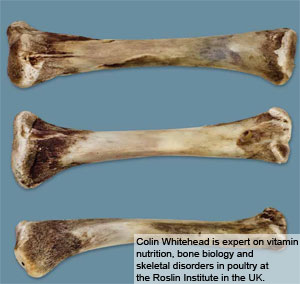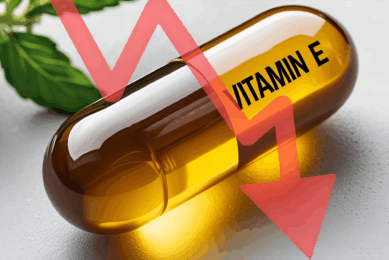Nutritional factors in broiler bone problems

Modern intensively-reared broiler strains have been selected over many generations primarily for fast growth of muscle tissues combined with good feed efficiency. But leg defects came to the forefront. For both broiler meat product quality and bird welfare it is therefore important to keep adequatelevels of vitamin D in the diet says Colin Whitehead.
By Colin Whitehead
When leg problems in broilers were increasing breeders started to pay more attention to skeletal characteristics in their selection practices. The result has been, with the odd notable exception, a general improvement in skeletal characteristics of the more recent broiler strains. Changes in management practices, aimed at improving leg health, have also been proving effective. Based on my recent observations in commercial broiler flocks around Europe, the greatest improvement seems to be in the non-specific rotational and angular deformities, of the valgus/varus type. However, bone problems have not yet been abolished. The increasingly greater growth rates and feed efficiencies of broilers put ever greater emphasis on optimising both nutritional and hygienic practices. Moreover, there have been genetic changes in bone structures, and these may need to be met by changes in nutrient specifications. There is also increasing evidence that some of these structural genetic changes may be resulting in new bone problems. The net result is that bone problems still occur, though their pattern is changing, and continued genetic, nutritional and management vigilance is needed to keep them under control.
Mechanisms of bone growth
Bone growth occurs in poultry in two ways. Longitudinal growth in long bones of the appendicular skeleton is brought about by a process called endochondral bone growth. This is based on the epiphyseal growth plate where some of the resting chondrocytes differentiate into proliferative chondrocytes. These cells multiply and form columns of flattish cells, then they start to differentiate into a hypertrophic state. They become enlarged and more rounded and start secreting a new matrix component, type X collagen. Bone formation starts in the lower hypertrophic zone, resulting in the development of a network of trabecular bone. As the bone elongates, the trabecular network is largely resorbed to form the marrow cavity. The long bones widen by a process involving intramembranous ossification. Osteoblasts develop in the perichondrium and produce spicules of bone that merge to produce a network of bone with cavities lined by osteoblasts. These cavities are gradually infilled by osteoblasts continuing to secrete concentric layers of lamellar cortical bone. At the endosteal surface, osteoclasts resorb bone so that the bone widens as an expanding ring, with bone formation on the outer surface and resorption on the inner. In the early growing period, the ring expands rapidly so that cavities do not become completely filled with bone before endosteal resorption commences but as growth slows the degree of infilling rises. This results in the bone having a porous appearance and there is evidence that porosity is increasing in more recent broiler genotypes.
FHN most widespread
Leg problems associated with endochondral bone growth Femoral head necrosis (FHN) seems to be currently one of the most widespread broiler leg problems. Strictly speaking, it is not a nutritional problem since it is a bacterial osteomyelitis associated mainly with Stappylococcus aureus, though sometimes with Eschericia coli. These bacteria can become trapped in the growth plate blood vessels, especially in the femoral head where blood flow may be weakest. But they may also become trapped in damaged or abnormal cartilage associated with nutritional problems such as rickets or tibial dyschondroplasia (TD), described below. The infection spreads initially to the chondrocytes, causing necrosis of these cells, before extending into the bone itself. The condition is painful and affected birds can be identified by their extreme reluctance to stand or walk.
Rickets
Deficiencies of calcium, phosphorus and/or vitamin D result in rickets in young birds. This results in delayed and poor calcification of bones. Growth plates are enlarged and the organic matrix of bone is undermineralised, resulting in low bone ash contents. Bones are soft and rubbery and other defects, such as beading of ribs, are also apparent. The morphology of the growth plate can be used to distinguish between the rickets caused by calcium/vitamin D deficiency or phosphorus deficiency. In the former, there is a considerable increase in the thickness of the proliferative zone, and the chondrocytes lose their ordered, columnar arrangement. In phosphorus deficiency rickets, the proliferative zone is relatively normal in size and structure but, instead, there is a considerable increase in the size of the hypertrophic zone and a delay in mineralisation of this zone. Rickets of both types can be caused by dietary deficiency or an imbalance in the proportions of calcium and phosphorus. Thus an excess of one can induce a deficiency of the other. Rickets can also occur with diets that are not overtly inadequate in calcium/phosphorus/vitamin D and in these cases the problem is thought to be caused by infections that impair nutrient absorption (malabsorption).
Tibial dyschondroplasia
Tibial dyschondroplasia (TD) is characterized by an accumulation or prehypertrophic chondrocytes resulting in a thickened layer of avascular cartilage between the proliferative and hypertrophic zones. The problem is caused by an impairment of the differentiation process that converts proliferative into hypertrophic chondrocytes, but the underlying mechanistic cause of this is not yet properly understood. Breeders can select against TD, using a Lixiscope, an x-ray fluorescence device. This device can detect large TD lesions, though small lesions are less easy, and its use has resulted in a decrease in the general incidence of TD in some broiler strains. However, TD still occurs in commercial broiler production. Several nutritional factors can influence the occurrence of TD, but the only nutrients that have so far been shown to completely prevent TD are vitamin D and its metabolites. 1,25-dihydroxyvitamin D (1,25-D) is particularly effective in the dose range 5 to 10 μg/kg (Edwards, 1989; Rennie et al., 1993), but has potential practical hazards from toxicity (Rennie et al., 1995). 25-hydroxyvitamin D has also shown to be effective, though at higher dose rates (75-250 μg/kg) (Rennie and Whitehead, 1996). It has a much higher toxic threshold than 1,25-D and is available commercially as HyD. More recent findings (Whitehead et al., 2004) indicate that vitamin D itself, when fed at high dose rates, can reduce or prevent the occurrence of TD, as described below.
Calcium and phosphorus requirements
The current NRC (1994) requirements for broilers for calcium and non-phytate phosphorus (NPP) are 1.0 and 0.45% respectively for starter and 0.9 and 0.35% for finisher diets. These nutrients are approximately in the ratio of 2.2:1, particularly for the starter diets, that corresponds with the ratio of Ca and P in bone mineral.
Studies on TD have suggested that better bone calcification was obtained if dietary calcium/available phosphorus was increased above 2.2/1 (Roberson et al., 1993). More recently, Williams et al. (2000a) compared the proportions of calcium and phosphorus in bones at different ages in two strains of broilers, one a very modern fast growing selected strain, the other an older, slower growing control strain. The results suggest that although the 2.2/1 ratio was broadly appropriate for the control strain, the ratio was higher during the early stages of growth of the selected strain. Subsequent studies have given further insight into this matter. An experiment has been reported in which histological characteristics of tibial growth plates were compared at 14 days in fast growing broilers fed diets containing different amounts of calcium and available phosphorus (Williams et al., 2000b). Changes associated with hypocalcaemic and hypophosphataemic rickets and TD were seen with the different diet combinations, but the combinations associated with the most normal growth plate morphology centred on a diet content of 1.2% calcium and 0.45% phosphorus. This finding thus suggests that the calcium requirement of the latest fast growing broiler strains is increasing for the early stages of growth and that dietary content of calcium and Ca:P ratio needs to be higher than current recommendations for starter diets. Requirements for calcium and phosphorus during the finisher period can be assessed on the basis of bone composition at the end of the finisher period; there is virtually no carry over effect of starter nutrition on bone composition because the fast growth of bones means that all bone formed during the starter period has been replaced completely by the end of the finisher period. Requirements have usually been assumed to be lower than for starting broilers, as suggested by NRC (1994) but a recent report by Bar et al. (2003) suggests that requirements for a modern strain may be higher than earlier estimates, up to 1.0% calcium and 0.48% non-phytate phosphorus.
Vitamin D
The broiler vitamin D3 requirement proposed by NRC (1994) is 200 IU/kg. However, there are widely differing requirement values reported from individual studies. In view of these uncertainties over the vitamin D requirement, we reassessed recently vitamin D3 requirements in 2 experiments under different combinations of Ca and P (Whitehead et al., 2004). The results showed that 200 IU vitamin D3/kg was clearly inadequate for growth and tibia ash and breaking strength. Higher dietary vitamin D3 levels could not overcome the most severe calcium/phosphorus imbalance, but dietary vitamin D3 levels above 5000 IU/kg could optimise performance and bone characteristics with less severe imbalances. TD incidence was affected considerably by dietary Ca/P but was also highly dependent upon vitamin D concentration. These results suggest that the vitamin D3 requirements of young broilers can be quite high and that responses in performance and bone characteristics can occur to dietary concentrations above 5000 IU/kg at both conventional and abnormal dietary calcium and phosphorus concentrations or ratios up to 14 days. Requirements for vitamin D may be lower in older broilers. The high requirements may indicate that the latest strains of broilers have higher requirements, perhaps as a result of changing bone growth characteristics and increasing calcium requirements, as discussed in the previous section. Conventional practical vitamin D3 supplements are normally in the range 3000-5000 IU/kg but, in view of the current findings, it would seem prudent to supplement at the higher end of this range or above if regulations permit, especially in broiler starter diets. Higher dietary vitamin D potencies can be obtained by replacement of a proportion of the feed vitamin D3 supplement with 25-hydroxyvitamin D3. Alternatively, additional vitamin D3 or 25-hydroxyvitamin D3 can be administered via the drinking water.
Black Bone Syndrome
The blackening of broiler leg bones and the spreading of the discolouration into adjacent meat, especially after cooking, has been reported intermittently in recent years. However, more recent observations on broiler processing lines and supermarket products are suggesting that the problem is much more widespread and fundamental than has been appreciated. It has implications for both broiler meat product quality and bird welfare and is now being described under the name black bone syndrome (BBS). BBS seems to be associated with leaking of blood from the marrow through the bone structure. This can be observed in freshly killed birds on processing lines, most frequently in the tibia but also sometimes in the femur. The leakage of blood in the tibia occurs in the proximal end, just below the growth plate. The blood may then diffuse down the bone under the periosteum. The problem of BBS seems to be made worse by freezing un-deboned leg portions. Presumably the freezing process forces more blood from the marrow through the bone and into adjoining meat. Cooking may contribute further to this process and also blackens the blood. The final result is a blackened and unappetising appearance of the meat surrounding the bone. We have found blackened bones to be widespread in frozen supermarket products and not connected to specific types or sources of broilers or broiler products. This is already having market impacts because there are now reports that fast-food outlets are stopping using frozen broiler leg portions or using deboned meat instead. BBS seems to be caused by a problem in intramembranous ossification. We have found the shaft of the bone immediately adjacent to the proximal growth plate, the area through which the blood is seen to be leaking, is quite thin. Histological examination has confirmed that the overall mineralised area is very thin and comprised of poorly connected strands of bone, of more cancellous than cortical appearance. There are obvious routes in this structure through which blood could seep and collect under the periosteal layer.
High vitamin D levels
So the BBS problem appears to have an underlying fundamental physiological cause, in which rapid bone formation in modern broilers is resulting in inadequately–mineralised bone. This is manifest at the moment in problems of product quality, but continuation of this trend may ultimately result in welfare problems for the birds themselves through development of pathological problems from bone structural defects. This has been followed up by comparing various characteristics of bone from another study on the feeding of HyD carried out by IRTA in Spain. The treatments involved supplementation of the diets of Ross and Cobb broilers with either 0 or 69 μg 25-hydroxyvitamin D (as HyD), in addition to a normal dietary content of vitamin D3. We measured the reflected optical density (as a measure of bone blackening) in the area of 10 to 15 mm from the proximal ends of frozen tibias. This measure of blackening was less in both breeds of broilers in birds given the vitamin D supplement and the overall effect was statistically significant (P=0.043).
It thus seems that ensuring good bone quality by feeding high levels of vitamin D can help to alleviate the problem of BBS.
Source: FeedMix vol 18 nr 1, 2010











